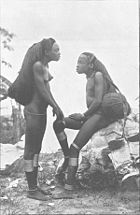
Ngbandi
Encyclopedia

Ubangi River
The Ubangi River , also spelled Oubangui, is the largest right-bank tributary of the Congo River of Central Africa. It begins at the confluence of the Mbomou and Uele Rivers and flows west, then bends to the southwest and passes through Bangui, after which it flows south to the Congo at Liranga....
, who inhabit the southern part of the Central African Republic
Central African Republic
The Central African Republic , is a landlocked country in Central Africa. It borders Chad in the north, Sudan in the north east, South Sudan in the east, the Democratic Republic of the Congo and the Republic of the Congo in the south, and Cameroon in the west. The CAR covers a land area of about ,...
and the northern part of the Congo
Democratic Republic of the Congo
The Democratic Republic of the Congo is a state located in Central Africa. It is the second largest country in Africa by area and the eleventh largest in the world...
. Their language, Ubangi, is in the Niger–Congo language family. The Ngbandi, traditionally, were simple farmers who still grow maize
Maize
Maize known in many English-speaking countries as corn or mielie/mealie, is a grain domesticated by indigenous peoples in Mesoamerica in prehistoric times. The leafy stalk produces ears which contain seeds called kernels. Though technically a grain, maize kernels are used in cooking as a vegetable...
, manioc and other food crops. Until recently, some of their subsistence depended on traditional hunting and gathering. They were once known as warriors, and some of the most prized African knives and lances were made by their craftspersons. There is clearly a close connection between this culture and others of Sudan, as evidence by shared usage of a musical instrument, a kind of harp
Harp
The harp is a multi-stringed instrument which has the plane of its strings positioned perpendicularly to the soundboard. Organologically, it is in the general category of chordophones and has its own sub category . All harps have a neck, resonator and strings...
, whose form is distinctive to this area.

